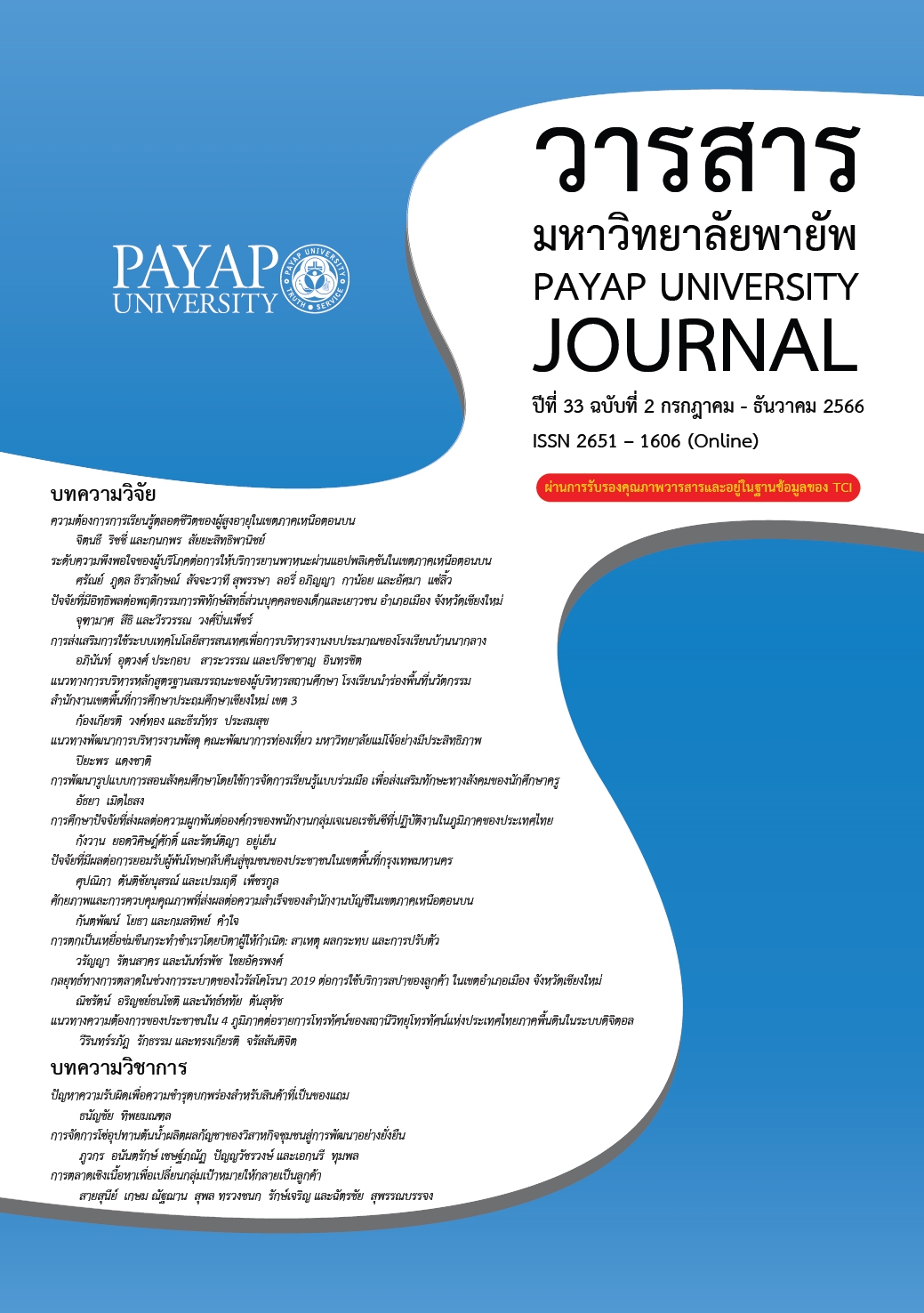ความต้องการการเรียนรู้ตลอดชีวิตของผู้สูงอายุในเขตภาคเหนือตอนบน
Main Article Content
บทคัดย่อ
การวิจัยครั้งนี้มีวัตถุประสงค์เพื่อศึกษาความต้องการการเรียนรู้ตลอดชีวิตของผู้สูงอายุในเขตภาคเหนือตอนบน 4 จังหวัด ประกอบด้วยเชียงใหม่ ลำพูน แม่ฮ่องสอน และลำปาง ใน 3 องค์ประกอบ ได้แก่ องค์ประกอบด้านสุขภาพ องค์ประกอบด้านความมั่นคงปลอดภัยในชีวิต และองค์ประกอบด้านเทคโนโลยีการสื่อสาร กลุ่มตัวอย่าง ได้แก่ กลุ่มผู้สูงอายุจำนวน 470 คน โดยวิธีการสุ่มตัวอย่างแบบเจาะจง เครื่องมือที่ใช้ในการวิจัย ได้แก่ แบบสอบถามแบบมีโครงสร้างมีค่าความตรงเชิงเนื้อหา 0.90 และค่าความเที่ยง 0.82 ผลการวิจัย พบว่า ผู้สูงอายุร้อยละ 55.11 มีความสนใจเข้าศึกษาในหลักสูตรผู้สูงอายุ โดยมีความสนใจเรียนรู้ในองค์ประกอบด้านสุขภาพมากที่สุด คิดเป็นร้อยละ 87.45 และมีความสนใจเรียนรู้ในองค์ประกอบด้านเทคโนโลยีสื่อสารน้อยที่สุด คิดเป็นร้อยละ 19.79 เหตุผลสำคัญสามลำดับแรกที่มีผลต่อการตัดสินใจในการเรียนรู้ คือ ค่าใช้จ่ายไม่แพง ร้อยละ 64.68 สถานที่เรียนใกล้บ้าน เดินทางสะดวก ร้อยละ 60.43% และเป็นโอกาสในการพัฒนาตนเอง ร้อยละ 53.83%
Article Details
เอกสารอ้างอิง
กรมกิจการผู้สูงอายุ (2562). มาตรการขับเคลื่อนระเบียบวาระแห่งชาติ เรื่องสังคมผู้สูงอายุ (พิมพ์ครั้งที่ 2). บริษัท อมรินทร์พริ้นติ้งแอนด์พับลิชชิ่ง จำกัด (มหาชน). ผู้แต่ง.
ฐิติมา ปานศรี และเทิดศักดิ์ ชมโต๊ะสุวรรณ. (2562). ความเหลื่อมล้ำทางด้านชีวิตดิจิทัลในประเทศไทย. วารสารประชากรศาสตร์, 35(2), 48-69. https://digital.car.chula.ac.th/cgi/viewcontent.cgi?article=1315&context=jdm
ปิยะ ศักดิ์เจริญ. (2558). ทฤษฎีการเรียนรู้ผู้ใหญ่และแนวคิดการเรียนรู้ด้วยการชี้นำตนเอง: กระบวนการเรียนรู้เพื่อการส่งเสริมการเรียนรู้ตลอดชีวิต. วารสารพยาบาลทหารบก, 16(1), 8-13.
ภารดี นานาศิลป์. (2558). แกนความรู้การพยาบาลผู้สูงอายุ: ผู้สูงอายุคือใคร อายุ หรือปัจจัยใดช่วยกำหนด. วารสารพยาบาลสาร, 42(พิเศษ), 156-162.
วิสุทธินี ธานีรัตน์. (2565). ความต้องการการเรียนรู้สู่การเป็นผู้สูงอายุที่มีพฤฒพลังของผู้สูงอายุในจังหวัดตรัง. วารสารการบริหารท้องถิ่น, 15(1), 79-97. https://so04.tci-thaijo.org/index.php/colakkujournals/article/view/256588
เวหา เกษมสุข, ศิรินา จิตต์จรัส, จิตรา มาคะผล, และปริญญา จิตอร่าม. (2562). แนวทางการส่งเสริมการเรียนรู้ตลอดชีวิตของโรงเรียนผู้สูงอายุ. วารสารพยาบาลตำรวจ, 11(2), 261-271.
ศศิพัฒน์ ยอดเพชร. (2544). การวิจัยทางสวัสดิการสังคม. โรงพิมพ์แห่งจุฬาลงกรณ์มหาวิทยาลัย.
ศักรินทร์ ชนประชา. (2562). การศึกษาตลอดชีวิต. วารสาร AL-NUR, 14(26), 159-175.
สุวัฒน์ วัฒนวงศ์. (2549). การวิจัยและประเมินผลการศึกษาผู้ใหญ่ (พิมพ์ครั้งที่ 2). จุฬาลงกรณ์มหาวิทยาลัย.
สำนักงานเขตสุขภาพที่ 8. (2563). รายงานประจำปี 2563. ผู้แต่ง.
สำนักบริหารการทะเบียน กรมการปกครอง. (2565).จำนวนประชากร. https://stat.bora.dopa.go.th/new_stat/webPage/statByYear.php
สำนักงานสภาพัฒนาการเศรษฐกิจและสังคมแห่งชาติ. (2562). รายงานการคาดประมาณประชากรของประเทศไทย พ.ศ. 2553 – 2583 (ฉบับปรับปรุง). ผู้แต่ง.
อนันต์ อนันตกูล. (2560). สังคมสูงวัย…ความท้าทายประเทศไทย. สำนักธรรมศาสตร์และการเมือง ราชบัณฑิตยสภา. http://legacy.orst.go.th/wp-content/uploads/2017/12/%E0%B8%AA%E0%B8%B1%E0%B8%87%E0%B8%84%E0%B8%A1%E0%B8%AA%E0%B8%B9%E0%B8%87%E0%B8%A7%E0%B8%B1%E0%B8%A23.pdf
อาชัญญา รัตนอุบล. (2562). การส่งเสริมการเรียนรู้สำหรับผู้ใหญ่และผู้สูงอายุในสังคมไทย. โรงพิมพ์แห่งจุฬาลงกรณ์มหาวิทยาลัย.
อาชัญญา รัตนอุบล, สารีพันธุ์ ศุภวรรณ, วีระเทพ ปทุมเจริญวัฒนา, มนัสวาสน์ มนัสวาสน์, วรรัตน์ ปทุมเจริญวัฒนา, ปาน กิมปี, ณัฏฐลักษณ์ ศรีมีชัย, สุวิธิดา จรุงเกียรติกุล และ ระวี สัจจโสภณ. (2555). การพัฒนาแนวทางการส่งเสริม การจัดการศึกษา/การเรียนรู้เพื่อการพัฒนาศักยภาพผู้สูงอายุ. Journal of Education Studies, 40(1), 14-28.
Knowles, M. S. (1984). Andragogy in action. Applying modern principle of adult education. San Francisco, CA: Jossey Bass.
Krejice, R. V., & Morgan, D. W. (1970). Determining sample size for research activities. Educational and Psychological Measurement, 30(3), 607-610.
Marsick, V. J., & Watkins, K. E. (2001). Information and incidental learning. New directions for adult and continuing education, 89, 25-34.


